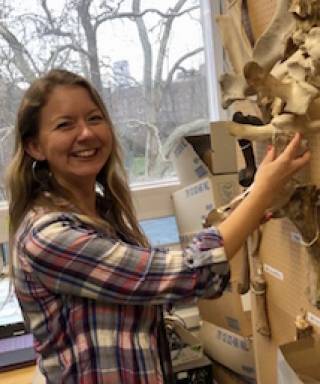Changing Human-Animal Interactions in post-Roman Britain: Can We Detect Socio-Economic and Cultural Change?
 | Email: lucy.sladen.14@ucl.ac.uk Supervisors: |
- Profile
Changing Human-Animal Interactions in post-Roman Britain: Can We Detect Socio-Economic and Cultural Change?
The transition from Roman Britain to early medieval England is a long-standing concern in history and archaeology. Traditional interpretations of gradual Roman societal decline predominated until the early 1980s, when theories of more dramatic social collapse and discontinuity began to be developed. Whilst some proponents of a discontinuity model have persisted in arguing for an abrupt end to Roman Britain, in the last two decades, it has been increasingly recognised that a 'one-size-fits-all' approach is unlikely to be the best solution to providing insight into a complex transition period. Differing interpretations have been advanced from a regional perspective in Britain, with the concept of a specific 'Late Antiquity' period garnering particular consideration.
Archaeology's role in understanding the transition has grown in importance since traditional historiographical interpretations began to be questioned, as has been demonstrated by a number of detailed artefactual and environmental studies (e.g. Dark 1996, Gerrard 2004, Cool 2014). This project aims to further extend the reach of archaeological enquiry through a nationwide study of faunal remains of the period. In doing this, the project addresses four main research questions:
- What does a national approach reveal about economic exploitation of animals between AD 350-650?
- What is the nature of wild and domestic animal use at English settlement and funerary sites, with a focus on regional nuances and temporal change?
- How were animals used socially and symbolically in terms of status and cosmology?
- To what extent is there evidence for 'empire' level economic and administrative collapse, and local production from faunal assemblages?
In answering these questions, the project will explore the nature of human-animal interactions in England between AD 350-650, synthesising data from hundreds of disparate faunal assemblages for the first time. For a period lacking substantial identifiable material culture from which to understand socio-economic change it is proposed that faunal data contributes to filling this void. Animals are an integral part of human existence; no past or present society functions without them. Therefore, identifying changes in the use of animals during this period in both economic and cosmological spheres of life will give insight into wider changes in human activity.
Funding
LAHP (AHRC)
Education
- BA, Archaeology and Anthropology, University of Cambridge, 2007
- MA, Archaeology, UCL, 2016
 Close
Close

